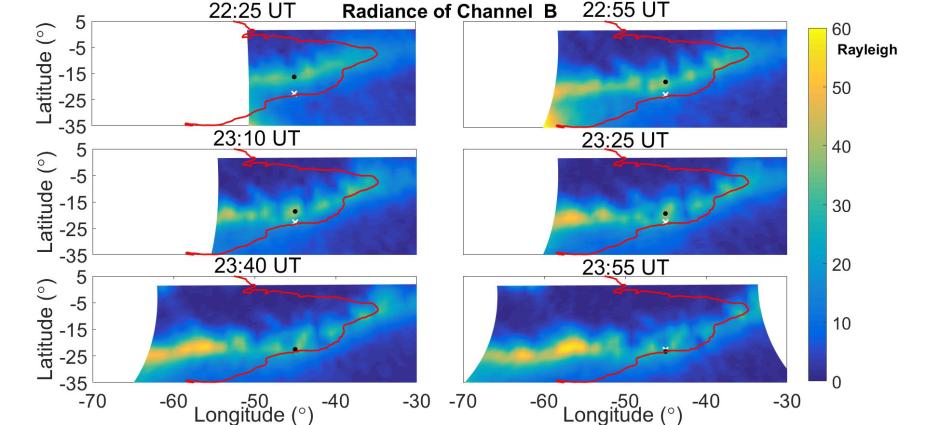Publication: Journal of Geophysical Research—Space Physics; Authors: Xuguang Cai, Alan G. Burns, Wenbin Wang, Liying Qian, Jing Liu, Stanley C. Solomon, Richard W. Eastes, Robert E. Daniell
The Global-scale Observation of Limb and Disk (GOLD) mission, for the first time, provides synoptic two-dimensional (2D) maps of OI 135.6 nm observations. These maps describe the unambiguous and dynamic evolution of nighttime ionospheric F2-peak electron densities (NmF2) as the 135.6 nm airglow emission radiance correlates well with NmF2 at night. On November 19, 2018, the 135.6 nm radiance measured by GOLD, NmF2 measured by a digisonde, and GPS total electron content (TEC) measurements at Cachoeira Paulista (CP) all showed a postsunset enhancement, with an increase near 22:30 universal time.

The latitude-longitude distribution of the OI 135.6 nm radiance measured by GOLD Channel B from 22:25 to 23:55 UT (22:25, 22:55, 23:10, 23:25, 23:40 and 23:55) on Nov 19, 2018. The white cross in each subplot marked the location of CP (22.7°S, 45°W), and the black point is the location of EIA southern crest peak at 45°W. The red line marked the coast line of South America continent. The white area on each subplot stand for the area that is not scanned by GOLD.
The 135.6 nm radiance map showed that this enhancement was due to the southward movement of the southern equatorial ionization anomaly (EIA) crest. Therefore, the GOLD observation showed the linkage between postsunset enhancement of NmF2 and EIA movement. Furthermore, unlike the southward movement of the southern crest, the corresponding EIA northern crest, however, did not show northward motion. This is the first time that the EIA hemispheric asymmetry, which included both different densities and movement of two crests in a short time period (less than 2-hours), was captured. The cause of this asymmetric movement of the two crests is not clear and requires further investigation.